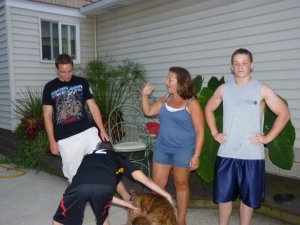I know. It seems a little wishy-washy to post about an affection of something I just broke up with last month. But I’d like to make a distinction between various meanings of “Paleo.” In some people’s minds, it is a strict set of foods that can or cannot be eaten, depending on your interest in obtaining and maintaining possession of the holy Paleo Card. This is how I first became aware of the newly publicized movement, more specifically through a multi-million view adorned sugar-bashing video by Dr. Robert Lustig (https://www.youtube.com/watch?v=dBnniua6-oM) that was posted on an OSU Army ROTC Facebook group page by a then MSIV, CDT Shell. If I remember correctly, the video led me to Lorain Cordain’s Paleo Diet for Athletes (http://www.amazon.com/The-Paleo-Diet-Athletes-Nutritional/dp/160961917X).
Alas, as with every living, breathing entity, the Paleo diet evolved. Transforming into the Paleo lifestyle movement, it now attempts to encompass all components of life that affect a human’s health and happiness. There are many different formats that attempt to map out all of the areas of focus, such as Paleo Treats’ Nik Hawks’ 7 Pillars of Paleo (http://www.paleotreats.com/pages/7-pillars-of-paleo), which demonstrates the importance of nutrition, sleep, exercise, water, community, mental health, and sunlight. While I would argue that other necessities in the list are nature, spirituality, joy, movement, and stress management, I think it is important to keep a wide view of holistic health, taking into account evolutionary precedence and scientific understanding of what each of these pillars manifest themselves as in society today.
It is all too easy to get pulled into placing all efforts into improvement and optimization of only a single element of health. I explored this trap for years, placing all of my efforts into discovering and practicing a “perfect” diet. This came, of course, at the expense of social health, sleep, and mental health as I would sometimes abstain from social gatherings or remain awake long into the night stressing over and researching the minute details of each and every morsel of food I may come into contact with and its physiological effects. With the realization that there must be a balance of effort placed on each aspect of wellness, I happily embrace the Paleo lifestyle’s intent to improve a person’s happiness through making the best decisions in all areas of health.
Are the 7-12 pillars listed above suitable to maintain the structure of your house of health?
If not, what model is most practical for your life?

Reblogged this on Grayson's Blog.
LikeLike
Reblogged this on Grayson's Blog.
LikeLike
I’m not quite sure how this reblogging/sharing/liking system works, but I only meant to do it once.
LikeLike
“Nutrition, sleep, exercise, water, community, mental health, and sunlight. While I would argue that other necessities in the list are nature, spirituality, joy, movement, and stress management.”
How do you differentiate between exercise and movement, or between water, mental health, and nature? It seems to me that some the suggestions you propose to add to the list are already manifested to a degree in the first seven. Or, the five you suggest are all results of the first seven.
If I had a healthy balance of each of the 12, I can’t think of anything else I would need. I would probably even have less wants, too.
LikeLike
Exercise and movement are commonly thought as one in the same, but I think it is important to distinguish the two. When I say exercise, I am referring to brief bouts of intense physical exertion, such as sprints, cross fit, bodybuilding style workout, running, or competing in a sport. Movement is the tendency for a person not to be sedentary in the hours outside of “exercise.” All too often someone participates in only one or the other, with dire consequences. This explains it fairly well: http://www.washingtonpost.com/lifestyle/wellness/even-with-exercise-long-periods-spent-sedentary-are-deemed-a-health-risk/2011/07/07/gIQAicwRAI_story.html
LikeLike
And yes, the components do tend to blend together and it is difficult to compartmentalize each of our actions into only one area of wellness. I think this is a good example, though, of how the reductionist approach to health just doesn’t usually work and everything is connected, as in the whole mind-body connection (http://www.nlm.nih.gov/medlineplus/magazine/issues/winter08/articles/winter08pg4.html) or long body ideas (https://geninelentine.wordpress.com/2011/02/23/the-long-body/). I have an immense affinity for this long body idea, that we are all part of the environment. Harm to our surroundings is harm to us.
LikeLike
Zack nice to meet you at AHSNZ in Queenstowns. All the best for your path..or what left on the path
LikeLike
Same! Hope our paths is littered with a nice supply of moderately hygeinic, nutritional, free food
LikeLike
Solid post!
I would say I totally agree with the pillars of wellness and those are some of the things that I find to be the most important part of paleo! When I started paleo, I didn’t have internet in my house so I just had to kind of wing it, I think now about how good that was for me as I wasn’t stressing about how authentic paleo something was. My main concern is/was always source of the food & it’s environmental impact. Sure green lipped mussels are paleo, but how good are they when they are in a grocery store in MI vs me picking them wild in nz? Things like this.
LikeLike
Well if the transportation didn’t rely on fossil fuels I wouldn’t have a problem with it… and it’s important to avoid the local trap (http://jpe.sagepub.com/content/26/2/195.abstract)
LikeLike